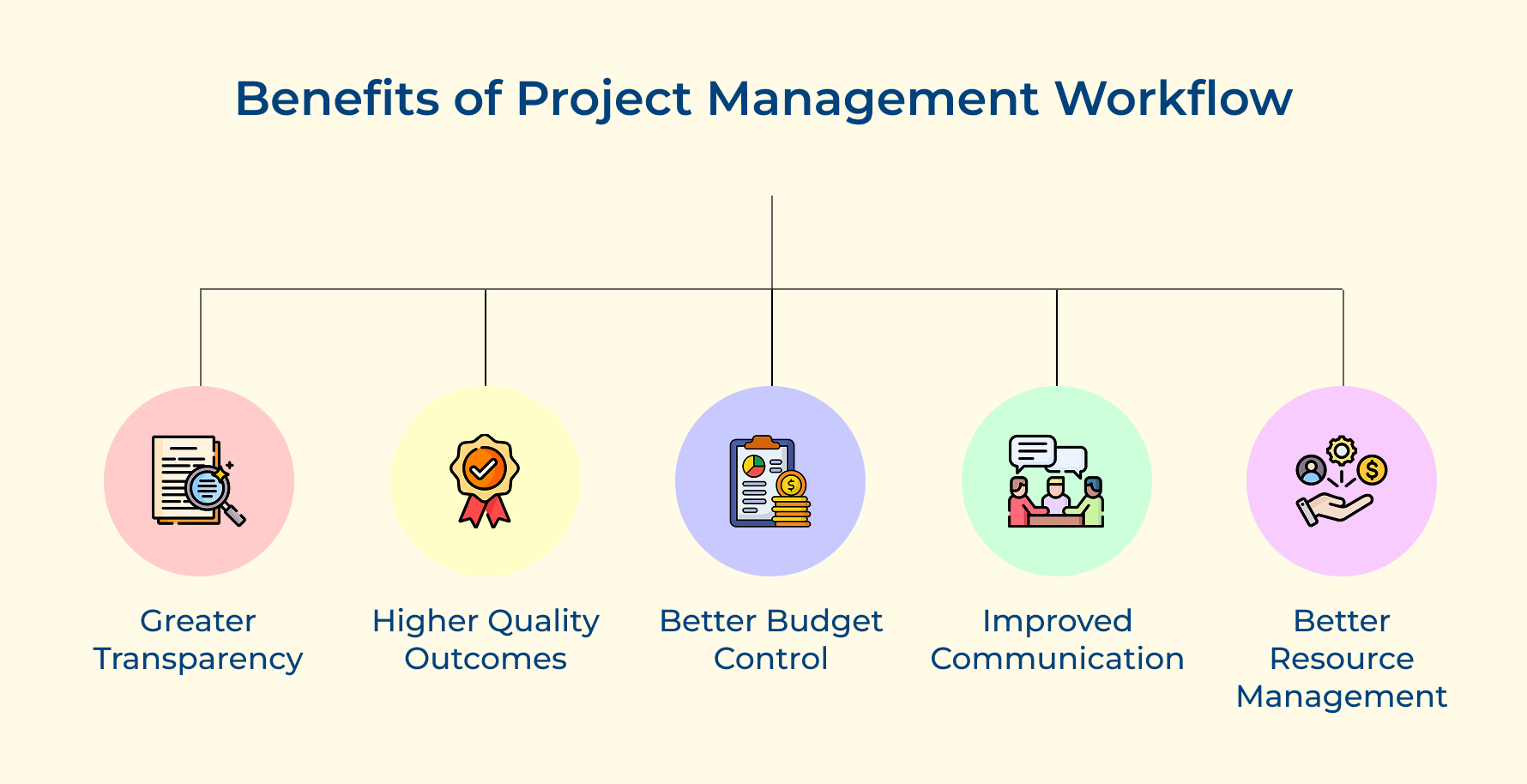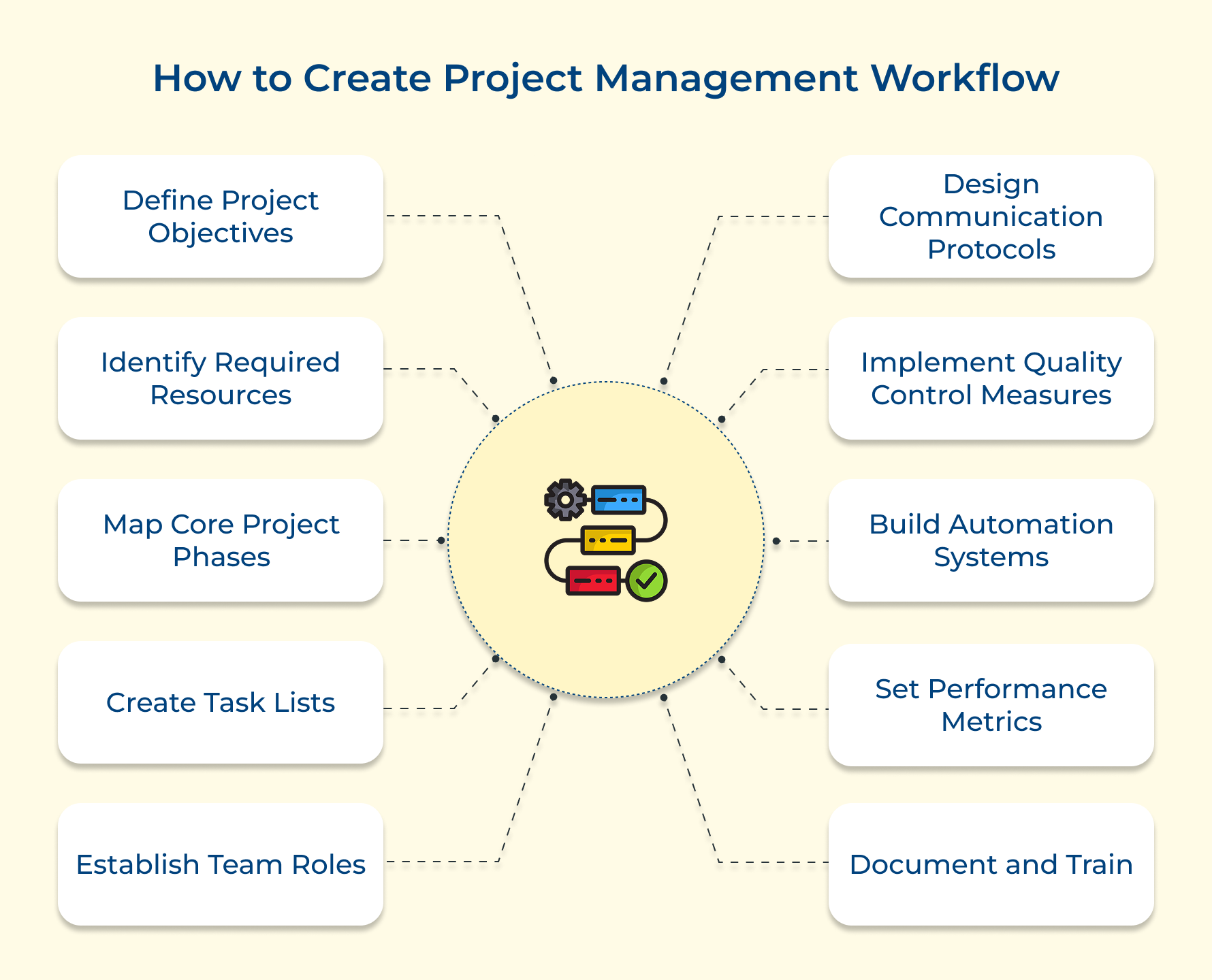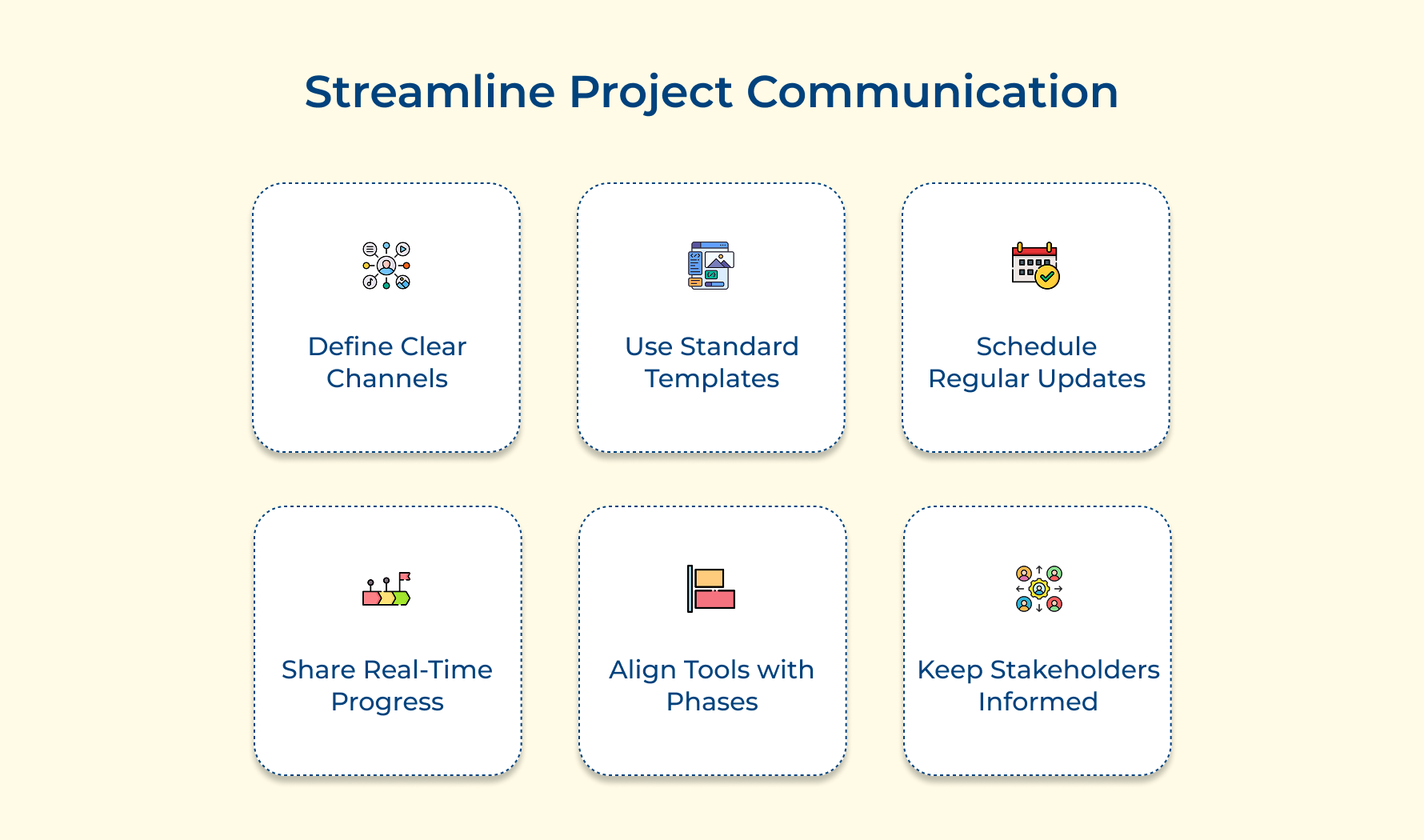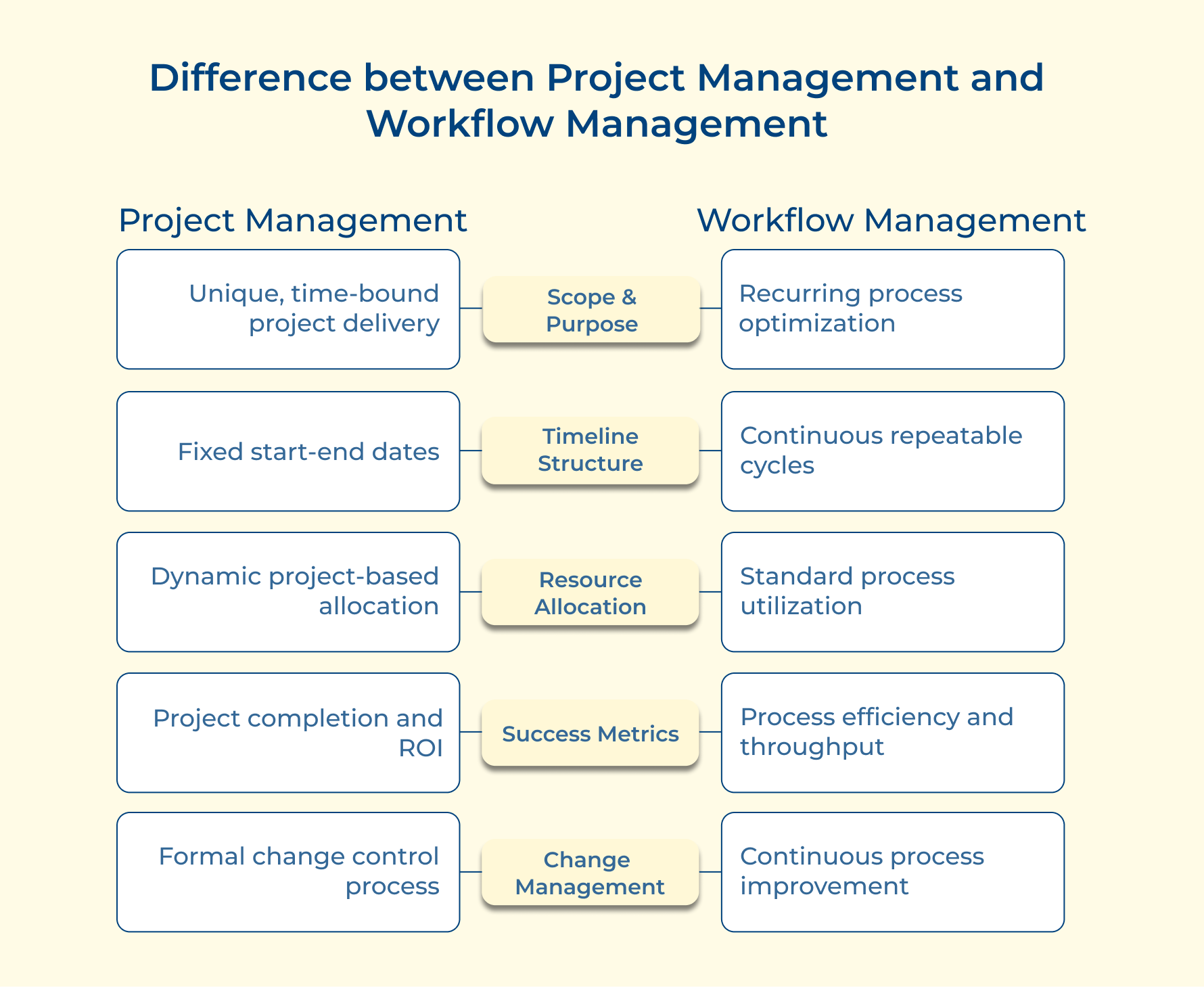A Comprehensive Guide to Creating Project Management Workflow
- What is a Project Management Workflow?
- Benefits of Efficient Project Management Workflow
- How to Create Project Management Workflow: Step-by-step Guide
- Difference between Project Management and Workflow Management
- 6 Project Management Workflow Best Practices
- Project Management Workflow: A Blueprint for Success
- FAQs about Project Management Workflow

Key Highlights:
- Project management workflow sets realistic deadlines ensuring project success by accounting for resources, obstacles, and team capacity.
- Clear approval chains prevent bottlenecks and ensure smooth decision-making with defined authority.
- Maintaining continuous feedback with stakeholders and team members refines deliverables, ensuring alignment with project expectations.
Modern businesses face a familiar challenge—project delays, resource mismanagement, and miscommunication. Unstructured workflows often spiral into scope creep and missed deadlines, leaving teams frustrated while also stakeholders disappointed. Sound relatable?
Poor workflow management doesn’t just disrupt timelines; it drains resources, exhausts teams, and derails deliverables. That’s why efficient workflows are no longer optional—they’re the backbone of project success.
The good news? Structured workflows keep everything on track. They improve resource management, boost stakeholder satisfaction, and deliver consistent, predictable results even for complex projects.
Our guide to project management workflows breaks down the essential elements of effective workflows and offers practical tips to implement them seamlessly, so you can tackle your next project with confidence.
What is a Project Management Workflow?
A project management workflow is a systematic sequence of tasks, processes, and activities that guide a project from initiation to completion. It’s essentially a repeatable pattern of procedures that define how work should progress through various stages while maintaining efficiency and quality standards.
A well-designed workflow enables better resource allocation, improves communication between stakeholders, and provides clear visibility into project progress. It helps identify bottlenecks early, allowing for timely interventions and adjustments to keep the project on track.
Key objectives:
- Efficiency enhancement: Streamline processes and eliminate redundancies to optimize resource utilization as well as reduce time wastage.
- Quality assurance: Establish checkpoints and review mechanisms to maintain consistent quality standards throughout the project lifecycle.
- Risk mitigation: Identify potential obstacles early and implement preventive measures to minimize project disruptions.
- Accountability creation: Define clear roles and responsibilities to ensure every team member understands their deliverables.
Benefits of Efficient Project Management Workflow
Efficient project management workflows streamline project timelines, empower project teams, and optimize project costs for seamless execution. Let’s explore other benefits it has to offer.
Greater Transparency
A solid workflow makes tracking project progress a breeze. Project managers can easily spot delays, adjust plans, and keep everyone in the loop. With this kind of visibility, both your team and stakeholders stay informed as well as aligned on the project’s status.
Higher Quality Outcomes
When workflows are efficient, projects are just better. Clear planning along with smooth execution leads to high-quality work, fewer mistakes, and happier clients. Everyone knows what’s expected, which makes delivering top-notch results so much easier.
Better Budget Control
Well-defined workflows mean fewer surprises. When tasks and milestones are mapped out, it’s easier to keep project costs in check as well as avoid scope creep. Managing budgets becomes more predictable and stress-free.
Improved Communication
Workflows set the stage for better communication. With regular updates and structured feedback, there’s less room for misunderstandings. Everyone stays connected as well as on the same page from start to finish.
Better Resource Management
Efficient workflows are all about using your resources wisely. By clearly outlining roles and timelines, project managers can avoid overloading anyone or leaving resources sitting idle. It’s all about balance and efficiency.
How to Create Project Management Workflow: Step-by-step Guide
Want to keep your projects on track? A solid workflow helps your team stay organized, meet deadlines, and manage costs with ease. Let’s explore its step-by-step guide.
1. Define Project Objectives and Scope
Setting clear goals and boundaries ensures smooth project execution. It helps teams stay aligned, prevents scope creep, and optimizes resource allocation.
1. Establish Clear Objectives
- Define specific and measurable goals to guide your team.
- Use SMART criteria (Specific, Measurable, Achievable, Relevant, Time-bound) to set realistic expectations.
2. Identify Project Scope
- Outline deliverables, constraints, and key stakeholders for clarity.
- Create a workflow diagram to provide a visual representation of scope boundaries.
3. Break Down Individual Tasks
- Divide the project into manageable tasks for easy tracking.
- Use workflow management software to assign responsibilities and monitor progress.
4. Document Everything
- Maintain a detailed scope statement to prevent misunderstandings.
- Regularly review the document to ensure alignment with original goals.
Pro tips:
- Conduct stakeholder interviews to capture all requirements.
- Use a scope matrix to define inclusions and exclusions, ensuring stakeholder sign-off.
2. Identify Required Resources
A well-planned resource strategy keeps projects on track and prevents bottlenecks while ensuring the right people / tools are available when needed.
1. List All Required Resources
- Identify human resources, equipment, technology, materials, and budget needs for successful execution.
- Align resources with the project scope to avoid shortages or excess.
2. Break Down Individual Tasks & Assign Resources
- Map resources to tasks based on skills, availability, and dependencies.
- Use a resource matrix to match team skills with project requirements.
3. Develop a Resource Allocation Plan
- Create allocation schedules to distribute resources efficiently.
- Maintain a resource calendar to track availability and prevent conflicts.
4. Use Resource Management Tools
- Implement workflow management software to monitor utilization rates and dependencies.
- Set up a resource forecasting system to predict future needs and avoid shortages.
Tips to consider:
- Build a skills vs. project requirements matrix to spot gaps early.
- Schedule regular resource reviews to ensure efficient use across multiple projects.
3. Map Core Project Phases
Breaking your project into clear phases keeps things organized, helps track progress, and ensures smooth transitions between stages.
1. Define Key Project Phases
- Break the project into clear, manageable stages (e.g., Planning, Execution, Review).
- Set entry and exit criteria for each phase to ensure structured progression.
2. Establish Phase Dependencies & Transitions
- Identify how each phase connects to the next to avoid roadblocks.
- Use a workflow diagram to show key dependencies and critical paths.
3. Set Milestones for Tracking Progress
- Create milestone charts to mark major achievements in each phase.
- Use these checkpoints to adjust timelines and keep stakeholders informed.
4. Leverage Visual Project Management Tools
- Build phase diagrams using project management software for clarity.
- Implement phase-gate reviews with specific criteria before moving forward.
Actionable tips:
- Use color-coded charts to visualize phases, tasks, and dependencies easily.
- Hold review meetings at each milestone to evaluate progress and make necessary adjustments.
4. Create Task Lists
Task listing is all about breaking a project into smaller, manageable steps. Instead of looking at one big goal, you divide it into specific tasks with clear ownership, deadlines, and dependencies.
A well-structured task list keeps things organized and prevents important steps from being overlooked. When tasks are clearly defined, team members can manage their time better and stay on track.
Using task management software can make this process even easier. It helps track assignments, monitor progress, and update stakeholders in real-time.
Pro tips:
- Break down complex tasks into subtasks no longer than 8 hours of work each for better estimation and tracking.
- Implement a consistent task naming convention and prioritization system across all project documentation.
5. Establish Team Roles
Role establishment involves defining clear responsibilities, authority levels, and accountability for each team member involved in the project’s execution.
Clear roles eliminate confusion about responsibilities, prevent task duplication, and ensure accountability. They create a structured environment where team members understand their contributions and authority limits.
Create detailed role descriptions and responsibility matrices. Use these to guide task assignments, decision-making processes, and communication flows throughout the project.
Actionable tips:
- Develop a detailed RACI matrix for all major project deliverables and review it with the team.
- Create role-specific onboarding documents that clearly outline responsibilities and authority levels.
6. Design Communication Protocols
Communication protocols help keep everyone on the same page by defining how, when, and where information is shared. With clear guidelines in place, team members and stakeholders always know what to expect, reducing confusion as well as miscommunication.
A structured approach ensures that critical updates reach the right people at the right time. Whether it’s daily check-ins, weekly reports, or milestone reviews, having a plan keeps everything running smoothly.
Using the right tools makes a big difference. Set up templates for reports, use project management software for real-time updates, and schedule regular meetings based on project phases.
Tips to consider:
- Create a communication matrix specifying which channels to use for different types of information and stakeholders.
- Develop standardized templates for all routine communications and project documentation.
7. Implement Quality Control Measures
Quality control keeps your project on track by ensuring deliverables meet expectations. Having the right checks in place, you avoid costly mistakes.
- Set Clear Quality Standards
Define what “good quality” looks like for your project. Align expectations with stakeholders and document key benchmarks. - Catch Issues Early
Regular quality checks help spot problems before they escalate. This saves time, money, and prevents rework. - Use Checklists & Testing Protocols
Standardized review processes ensure every deliverable meets expectations. Checklists keep evaluations consistent and thorough. - Establish Quality Checkpoints
Set milestones for quality reviews at different project stages. It keeps deliverables on track and up to standard. - Document & Improve
Track quality issues, learn from them, and refine processes for future projects. Continuous improvement keeps quality high.
Pro tips:
- Develop comprehensive quality checklists for each major deliverable type with clear pass/fail criteria.
- Implement peer review processes with standardized feedback forms for all key deliverables.
8. Build Automation Systems
Automation systems are tools and processes that streamline routine tasks, notifications, as well as workflow transitions, reducing manual effort while also improving consistency.
Automation reduces human error, speeds up routine processes, and ensures consistent execution of repeatable tasks. It frees up team members to focus on more valuable activities.
Implement project management software with automation capabilities. Set up automated notifications, approval workflows, and status updates for routine project activities.
Actionable tips:
- Map out repetitive processes and create automated workflows for approval chains along with notifications.
- Implement automatic data collection and reporting systems for key project metrics.
9. Set Performance Metrics
Performance metrics help track project progress, efficiency, and overall success. They include KPIs, milestones, and other measurable indicators that show how well things are moving.
Right metrics enables teams to make data-driven decisions, spot potential issues early, and ensure the project stays on track. It also provides a clear picture of what’s working and what needs improvement.
Set up dashboards to display key metrics in real time and create regular performance reports. Tracking trends helps you adjust plans as needed, keeping everything running smoothly and ensuring the project meets its goals.
Pro tips:
- Select no more than 5-7 core KPIs that directly align with project objectives and success criteria.
- Create automated dashboard reports that update in real-time and are accessible to all stakeholders.
10. Document and Train
Documentation and training involve creating comprehensive guides, procedures, as well as training materials while ensuring team members understand how to follow established workflows.
Proper documentation ensures consistency and provides reference materials for current/future projects. Training ensures team members can effectively execute their roles within the workflow.
Create detailed procedure manuals and conduct regular training sessions. Maintain living documentation that evolves with project needs and lessons learned.
Tips to consider:
- Create a central knowledge repository with version control for all project documentation and training materials.
- Develop interactive training modules with practical exercises and regular refresher sessions.
Difference between Project Management and Workflow Management
Project management focuses on planning, executing, and completing projects, while workflow management streamlines recurring processes for consistency. Let’s explore their differences.
1. Scope and Purpose
Project Management is all about handling unique projects with specific goals and timelines. It covers everything from planning to execution and closure.
Workflow Management improves ongoing processes and task sequences. It’s all about streamlining daily operations and ensuring smooth transitions between team members at each stage.
2. Timeline Structure
Project Management deals with projects that have clear start and end dates. It follows structured schedules and milestone-based timelines, customized for each project’s unique needs.
Workflow Management, however, focuses on continuous, repeatable processes. It aims to optimize efficiency in recurring tasks that follow established patterns and cycles, ensuring smooth, ongoing operations.
3. Resource Allocation
Project Management involves dynamic resource allocation, adjusting resources like budget, personnel, and equipment throughout different project phases to meet specific needs as well as constraints.
Workflow Management optimizes the use of existing resources within established processes. It ensures efficient resource utilization for recurring tasks and regular operations, maintaining smooth ongoing performance.
4. Success Metrics
Project management measures success through completing the project on time, staying within budget, and satisfying stakeholders. It focuses on achieving specific outcomes and evaluating ROI.
Workflow management assesses efficiency, throughput, and consistency within processes. It uses performance metrics and KPIs to measure ongoing operations, focusing on continuous improvement as well as optimizing processes.
5. Change Management
Project Management handles significant changes through formal change control processes, requiring stakeholder approval for major project modifications and adaptations.
Workflow Management focuses on incremental process improvements, refining existing workflows for ongoing efficiency. It makes continuous adjustments to enhance operational performance.
6 Project Management Workflow Best Practices
Mastering project management workflows is key to delivering projects on time and within budget. Here are six best practices to streamline your process and boost efficiency.
Implement Clear Approval Chains
Establish explicit approval hierarchies and decision-making protocols. Define who has authority for different types of decisions and create streamlined approval processes. Avoid bottlenecks by setting response time expectations and including backup approvers for critical paths. Document all decisions as well as their rationales.
Set Realistic Deadlines
Be realistic when setting timelines for each task and project phase. Deadlines should take into account available resources, potential obstacles, and team bandwidth. Avoid overly ambitious timelines that may lead to burnout or missed deadlines.
Define Escalation Procedures
Create clear pathways for issue escalation as well as problem resolution. Establish criteria for when and how to escalate problems. Define response time expectations for different severity levels. Document all escalations and their resolutions for future reference.
Maintain Quality Control Checkpoints
Establish quality gates at critical stages of the workflow. Create clear criteria for passing quality checks. Implement peer review processes for important deliverables. Document quality standards and maintain consistent enforcement across all project phases.
Ensure Continuous Feedback and Collaboration
Encourage continuous feedback loops with stakeholders, team members, and clients. Regular feedback helps refine deliverables and ensures that the project meets expectations. Collaboration also builds innovation and better problem-solving.
Anticipate and Mitigate Risks
Identify potential risks early on and develop mitigation strategies. Being proactive in risk management ensures that unforeseen challenges don’t derail the project. Regularly assess and address risks as the project progresses.
Project Management Workflow: A Blueprint for Success
Effective project management workflows transform chaotic project environments into streamlined, productive systems. Organizations embracing structured workflows witness measurable improvements in project delivery, team collaboration, and stakeholder satisfaction.
Remember, workflows serve as guiding frameworks rather than rigid rules. Smart adaptation, coupled with continuous improvement efforts, ensures long-term project success and sustainable organizational growth.
Your next step? Start small, implement gradually, and scale systematically for lasting impact.
Limit time — not creativity
Everything you need for customer support, marketing & sales.
Neeti Singh is a passionate content writer at Kooper, where he transforms complex concepts into clear, engaging and actionable content. With a keen eye for detail and a love for technology, Tushar Joshi crafts blog posts, guides and articles that help readers navigate the fast-evolving world of software solutions.



